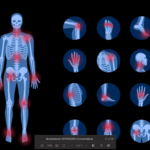Nine years later, he required increasing doses of prednisone, and he developed rheumatoid nodules, dyspnea on exertion and fatigue. He was subsequently hospitalized for a deterioration of hypoxemic respiratory failure with pulmonary infiltrates seen on imaging. Two weeks later he died from respiratory failure.
Case No. 2
A 72-year-old man, the brother of the aforementioned patient with a history of membranous nephropathy, controlled with cyclosporine, and celiac disease, presented with an episode of acute right knee pain, swelling and warmth. Symptoms resolved spontaneously.
He then developed multiple episodes of intermittent tenderness, stiffness and weakness of both carpometacarpals (CMC) and MCPs, which resolved with deep massage and heat. There were also numerous episodes of abrupt onset, intense pain occurring in several joints (especially the shoulders) that worsened with movement, occurred mainly at night and lasted 24–36 hours.
The patient was diagnosed with osteoarthritis with cervical radiculopathy due to the variability of his symptoms, no joint findings and X-ray evidence of cervical spondylosis. Symptoms improved with conservative measures, including swimming and physical therapy.
Ten months after the initial episode, he had a more intense presentation of acute left shoulder pain. An ultrasound revealed severe inflammation, mostly in tendons. Serologies were suggested, but not obtained.
A year later, similar symptoms developed in his right shoulder, with the subsequent rupture of the long head tendon of his right bicep. This led to his first encounter with a rheumatologist. The exam revealed RA joint changes in both hands and positive RF and anti-CCP, confirming the diagnosis.
He was started on hydroxychloroquine sulfate, methotrexate, naproxen, low-dose prednisone and cyclosporine. Eighteen months later, he developed rheumatoid nodules and a skin rash compatible with RA vasculitis. Cyclosporine was discontinued, and adalimumab was used briefly, but not tolerated; currently he is on rituximab with good response.
Discussion
It remains controversial whether PR represents a spectrum of RA or is a completely separate entity. With similarities of positive RF serology, anti-citrullinated peptide/protein antibodies (ACPA) and the evolution of many of these patients to chronic, erosive diseases, such as RA, more questions than answers prevail.4,5
It remains unclear what prognostic factors predict which patients will go on to develop malignant RA and which will remain in prolonged remission. Understanding this may be key in the early, targeted management of patients at risk to avoid chronic, debilitating disease.
The ultimate treatment strategy also remains unclear, although several reports have shown a good response to NSAIDs and antimalarial drugs, possibly delaying chronic arthritis.6


